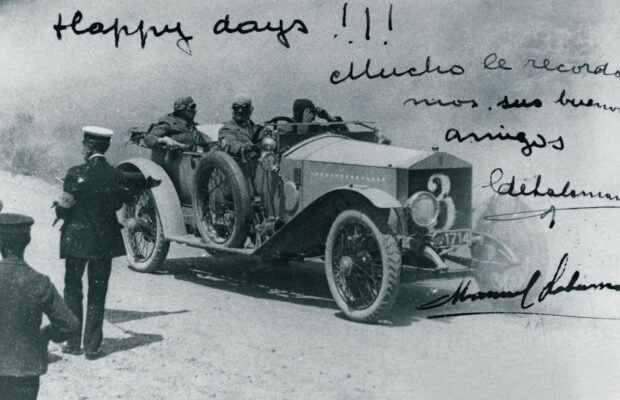Celebrating Triumph: Rolls-Royce Commemorates 110 Years Since Historic Win at the 1913 Spanish Grand Prix

- · Rolls-Royce marks the 110th anniversary of its emphatic win at the first-ever Spanish Grand Prix on 15 June 1913
“Rolls-Royce’s dominance of long-distance trials in the early 20th Century is well-known; but motor-racing, especially in continental Europe, was also crucial in securing the marque’s reputation for performance and reliability. Today, we look back on the Silver Ghost’s victory in the inaugural Spanish Grand Prix on 15 June 1913, which was a triumph not only of Henry Royce’s technology, but also of team spirit and self-sacrifice.” Andrew Ball, Head of Corporate Relations, Rolls-Royce Motor Cars
Today, Rolls-Royce marks the 110th anniversary of the 1913 Spanish Grand Prix in which Silver Ghosts took first and third places – a technical and tactical domination that would set the template for the marque’s legendary triumph at the 1913 Alpenfahrt a few weeks later.
It was a victory built on three foundations: the Silver Ghost’s overwhelmingly superior engineering and performance; deliberate team tactics executed to perfection; and the self-sacrifice of one of Rolls-Royce’s most experienced and devoted employees.
RACING AHEAD
In the early 20th Century, endurance trials were the principal means for motor manufacturers, including luxury marques like Rolls-Royce, to demonstrate their products’ capabilities. Rolls-Royce had an enviable record in these gruelling tests, having demolished the field in a series of blue riband events including the 15,000-mile Scottish Reliability Trial in 1907, and the legendary run from London to Edinburgh in 1911, which was completed entirely in top gear.
During the same period, motor-racing was also rapidly growing in both sophistication and popularity. in 1906, France staged its first Grand Prix, under the auspices of the Automobile Club de France, of which the Hon. Charles Stewart Rolls, a successful motor-racing pioneer himself, had been a member since the age of 18.
As a rule, the company preferred trials to racing; but by 1913, three years after Rolls’ tragic early death, managing director Claude Johnson was keen to boost sales in Europe, and saw Continental racing as another important promotional opportunity.
The company therefore entered two Silver Ghosts in the inaugural Spanish Grand Prix, to be held on 15 June 1913.
HIGH ENDEAVOURS
The Spanish Grand Prix appealed to Rolls-Royce because it was a test of endurance and reliability – at which the Silver Ghost naturally excelled – not just raw speed.
The 192-mile course comprised three laps and included two formidable passes in the rugged Guadarrama mountains, northwest of Madrid. It was open exclusively to four-seater touring cars, which had to be fitted with mudguards, lamps, hoods and two spare tyres. Bonnets were sealed, and no water could be added to the radiator once the race was under way, despite a shade temperature well above 30°C at the start in La Granja.
Two modified Silver Ghosts were among the 17 starters. The first was owned and (against the company’s express wishes) driven by Don Carlos de Salamanca y Hurtado de Zaldivar, later Marqués of Salamanca, who had recently become Rolls-Royce’s new agent in Madrid.
The second was a company-owned Silver Ghost driven by Eric Platford, one of Rolls-Royce’s most experienced and dedicated engineers, who had been responsible for many of the marque’s previous trials successes.
STRATEGY AND SACRIFICE
Three hours into the race, Platford had built up a commanding lead of more than 20 minutes. But this was a hard-headed commercial undertaking, not just a sporting challenge, and Platford was racing under strict instructions. Setting aside his own personal ambitions, he therefore pulled over and allowed Don Carlos de Salamanca to pass him. The company’s Madrid agent went on to win his home nation’s first-ever Grand Prix race in a time of 3 hours, 34 minutes and 12 seconds, at an average speed of 54mph.
Sadly for Platford, his selfless manoeuvre also opened the door for another rival, the Marqués de Aulencia in a Lorraine-Dietrich, who took second place just three minutes ahead of him – a very narrow margin in an age when races could still be won or lost by hours.
JUST REWARDS
Platford’s sacrifice did not go unrewarded, however. After the race, he drove his car to Madrid, where he received a congratulatory telegram from Claude Johnson; he was later awarded a holiday in Venice, partly as a gift and partly to escape the inevitable press attention. He also received two gold watches by way of compensation: one presented by the Rolls-Royce directors – and the other by a very grateful Don Carlos de Salamanca.
ON TO THE ALPENFAHRT
The 1913 Spanish Grand Prix victory came just a week before the start of the 1913 Alpenfahrt, the daunting 1,600-mile trial through the Alps. Platford, as team manager, would lead the Rolls-Royce works team to a clean sweep of the top four places, sealing the Silver Ghost’s reputation, described in the media as ‘the best car in the world’. In his team spirit, dedication, selflessness, courage and constant pursuit of excellence, he perfectly exemplifies the ethos of Inspiring Greatness, which continues to resonate at the heart of the marque today.






















0 comments